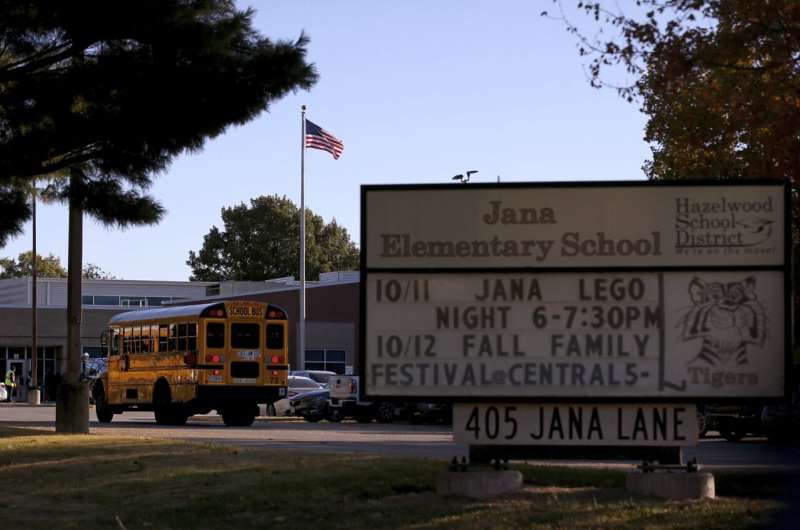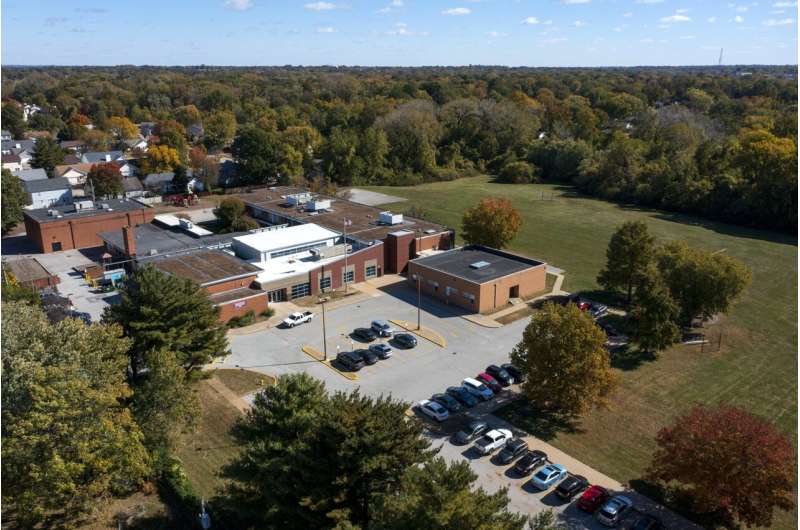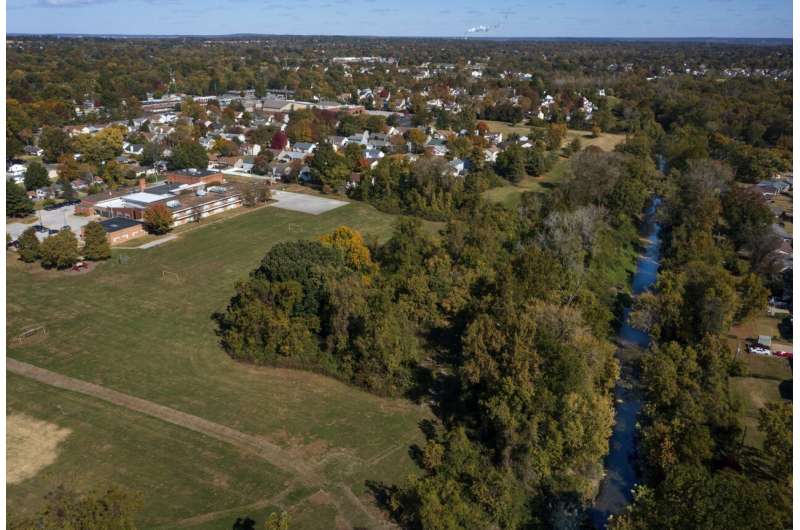A school bus arrives at Jana Elementary School on Monday, Oct. 17, 2022 in Florissant, Mo. Radioactive samples were found at the Hazelwood School District school, according to a recently released report. Nearby Coldwater Creek, which flooded in August, was contaminated by waste from nuclear bombs manufactured during World War II. Credit: Christian Gooden/St. Louis Post-Dispatch via AP
Radioactive waste in a creek that meanders through part of suburban St. Louis has long been suspected of causing rare cancers and other health problems for residents who live nearby. Now, a new study funded by law firms suing on behalf of residents of the area has created worry that contamination is inside a grade school.
Contamination was found in classrooms, the playground and elsewhere at Jana Elementary School in Florissant, Missouri, according to a report last week by Boston Chemical Data Corp. It follows another study by the U.S. Army Corps of Engineers, made public in June, that found contamination stemming from World War II-era nuclear weapons production in a wooded area near Coldwater Creek, which runs past the school.
Phillip Moser, program manager of the Corps of Engineers' Formerly Utilized Sites Remedial Action Program in St. Louis, said Corps evaluations found no contamination between the wooded site and the school or its playground. He called the Boston Chemical report "incomplete and not consistent with the approved processes required to do an evaluation at one of our sites."
Still, the new report worried parents, especially since the federal Agency for Toxic Substances and Disease Registry stated in 2019 that people exposed to Coldwater Creek from the 1960s to the 1990s may have an increased risk of bone cancer, lung cancer and leukemia.
For now, students are still attending the school. The Hazelwood Board of Education planned a closed meeting Tuesday night to decide what to do next.
"Safety is always our top priority, and we are actively discussing the implications of the finding," a statement from the district read. "The Board of Education will be consulting with attorneys and experts in this area of testing to determine next steps."
The school's parent-teacher association is urging the district to immediately begin remediation, even if it means relocating kids to another building.
This aerial photo shows Jana Elementary School, in the Hazelwood School District, Monday, Oct. 17, 2022 in Florissant, Mo. Elevated levels of radioactive waste were found at the school, according to a recent report, and the parent-teacher association wants an open public meeting to discuss it. Nearby Coldwater Creek, hidden by a line of trees next to the field to the right, which is prone to flooding, was contaminated by waste from nuclear bombs manufactured during World War II. Credit: David Carson/St. Louis Post-Dispatch via AP
"We are really hoping to hear the kind of support that will make sure our school gets cleaned up," PTA President Ashley Bernaugh, who has a child at the school, said.
Nuclear waste from World War II weapons production as part of the Manhattan Project contaminated Coldwater Creek. Mallinckrodt Chemical Co. processed uranium ore in St. Louis from 1942 to 1957 and shipped waste to a site near Lambert Airport, where it made its way into the 19-mile-long waterway that flows into the Missouri River.
The Environmental Protection Agency designated the creek as a Superfund site in 1989. Remediation efforts—digging up contaminated dirt and taking it by covered rail car to a waste management facility in Idaho—aren't expected to be complete until 2038.
Dawn Chapman, co-founder of the environmental group Just Moms STL that has pushed for cleanup of Coldwater Creek, acknowledged the difficulty in connecting illnesses to contamination. But Chapman said the new report—funded by two law firms seeking compensation for illnesses and deaths allegedly caused by the creek contamination—has created worry for current and former parents, teachers and staff.
"Everybody's just terrified," Chapman said.
The Boston Chemical study cited levels of radioactive isotope lead-210 that were 22 times the expected level on the kindergarten playground. It also found high levels of polonium, radium and other material in various places throughout the school.
Mahadevappa Mahesh, chief physicist at the teaching hospital at Johns Hopkins University School of Medicine in Baltimore, called the data "bothersome," but said he needed more information to reach firm conclusions about the potential health effects.
Jana Elementary School, left, which is in the Hazelwood School District, is seen on Monday, Oct. 17, 2022 in Florissant, Mo. Elevated levels of radioactive waste were found at the school, according to a recent report, and the parent-teacher association wants an open public meeting to discuss it. Coldwater Creek, right, which is prone to flooding, was contaminated by waste from nuclear bombs manufactured during World War II. Photo by David Carson, dcarson@post-dispatch.com/St. Louis Post-Dispatch via AP)/St. Louis Post-Dispatch via AP)
"The psychological impact is greater than even the actual physical injury," said Mahesh, also a professor of radiology. "Now that the students and the parents know these things, that can have a lot more psychological impact—worrying about the radiation—more than actual radiation injuries."
The school—which sits in a subdivision surrounded by homes—opened in the 1970s and has educated thousands of children, said Christen Commuso of the Missouri Coalition for the Environment. While the area along Coldwater Creek is racially mixed, about 80% of Jana Elementary School's 400 students are Black.
"You're talking about kids throughout the decades who have been exposed to this." Commuso said.
Eventually, Bernaugh said, she wants her son to be back at the school.
"We love Jana Elementary," Bernaugh said. "I'll go down fighting for it."
___
AP reporter John Hanna in Topeka, Kansas, contributed to this report.
© 2022 The Associated Press. All rights reserved. This material may not be published, broadcast, rewritten or redistributed without permission.
























